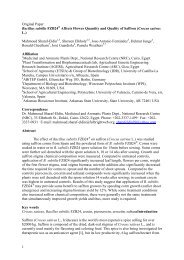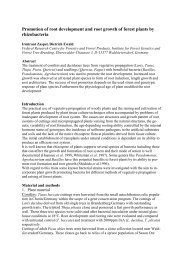Bacillus amyloliquefaciens - ABiTEP GmbH
Bacillus amyloliquefaciens - ABiTEP GmbH
Bacillus amyloliquefaciens - ABiTEP GmbH
Create successful ePaper yourself
Turn your PDF publications into a flip-book with our unique Google optimized e-Paper software.
VOL. 186, 2004 BACILLUS LIPOPEPTIDES 1085<br />
should allow identification of additional genetic elements involved<br />
in the complex network responsible for rhizosphere<br />
competence. We present a preliminary comparison of the B.<br />
subtilis 168 genome to sample sequences of the genome of<br />
FZB42, primarily focused on biosynthesis of biologically active<br />
cyclic lipopeptides. Gene clusters involved in surfactin, bacillomycin<br />
D, and fengycin synthesis were identified in the FZB42<br />
genome. We found that bacillomycin D and fengycin act in a<br />
synergistic manner, enabling FZB42 to cope with competing<br />
organisms within plant rhizosphere.<br />
(The results of this study were presented in part at the<br />
Functional Genomics of Gram-Positive Microorganisms Meeting,<br />
12th International Conference on Bacilli, 22 to 27 June,<br />
2003, Baveno, Italy.)<br />
MATERIALS AND METHODS<br />
Strains, plasmids, growth conditions. The strains and plasmids used in this<br />
study are listed in Table 1. Strains were cultivated routinely on Luria broth (LB)<br />
medium solidified with 1.5% agar. For biosurfactant production and MALDI-<br />
TOF-MS characterization, the bacteria were grown either in Landy medium (18)<br />
or sucrose-ammonium citrate medium (ACS) (10). To prepare surface cultures,<br />
the strains were grown in petri dishes containing 1.5% Landy agar for 24 h at<br />
37°C and stored at room temperature prior to MALDI-TOF-MS analysis. Fermentation<br />
in liquid media was carried out in 500-ml flasks at 30°C and 180 rpm<br />
in a New Brunswick shaker (New Brunswick Scientific Co., Edison, N.Y.). The<br />
media and buffer used for DNA transformation of <strong>Bacillus</strong> cells were prepared<br />
according to the method of Kunst and Rapoport (15).<br />
DNA transformation. Competent cells were prepared according to the method<br />
of Kunst and Rapoport (15), with slight modifications, as follows. FZB42 cells<br />
were grown in 10 ml of glucose-casein hydrolysate-potassium phosphate buffer<br />
(GCHE) medium under vigorous shaking (220 rpm) at 37°C until an optical<br />
density at 600 nm of 1.4 was reached. Then, 10 ml of GC medium without casein<br />
hydrolysate was added, and the culture was incubated under the same conditions<br />
for 1 h. The cells were harvested, and the pellet was resuspended in 1 ml of<br />
supernatant containing 0.5% glucose. Subsequently, 100 ng of DNA was added<br />
to 0.2 ml of cell suspension and incubated for 20 min. Finally, the cells were<br />
cultivated in LB medium with inducing (sublethal) concentrations of the appropriate<br />
antibiotics for 90 min before they were plated on selective agar.<br />
Sequencing strategy. The genome of B. <strong>amyloliquefaciens</strong> FZB42 was sequenced<br />
by using the random shotgun approach. Total genomic DNA was<br />
sheared randomly or partially digested with Sau3AI, and DNA fragments 1 to 3<br />
kb in size were cloned into pTZ19R or pCR2.1 TOPO (Invitrogen) to establish<br />
a shotgun library. The inserts of the recombinant plasmids were sequenced from<br />
both ends by using MegaBACE DNA Sequencing Systems 1000 and 4000 (Am-<br />
TABLE 1. Strains and plasmids used<br />
Strain or plasmid Description a Source and/or reference<br />
B. <strong>amyloliquefaciens</strong><br />
FZB42 Producer of surfactin, fengycin, and bacillomycin D FZB Biotech <strong>GmbH</strong> Berlin (11)<br />
AK1 �bmyA::Em r<br />
This study<br />
AK2 �fenA::Cm r<br />
This study<br />
AK3 �bmyA::Em r �fenA::Cm r<br />
This study<br />
CH1 �srfA::Em r<br />
This study<br />
Plasmids<br />
pMX39 Ap r Em r Tet r<br />
pDG364 amyE; Ap r Cm r<br />
pGEM-T Cloning vector; Ap r<br />
pAK1 pGEM-T carrying a 1.2-kb fragment from bmyA; Ap r<br />
pAK2 pGEM-T carrying bmyA::Em r ;Ap r Em r<br />
pAK3 pGEM-T carrying a 1.3 kb fragment from fenA; Ap r<br />
pAK4 pGEM-T carrying fenA::Cm r ;Ap r Cm r<br />
pCH1 pGEM-T carrying a 2.3-kb fragment from srfA::Em r ;Ap r<br />
a Ap r , ampicillin resistance; Em r , erythromycin resistance; Tet r , tetracycline resistance.<br />
Derivative of pDB101 (3)<br />
Integrative vector (6)<br />
Laboratory stock<br />
This study<br />
This study<br />
This study<br />
This study<br />
This study<br />
ersham Biosciences) and ABI Prism 377 sequencers (Applied Biosystems) with<br />
dye terminator chemistry.<br />
Approximately 39,500 sequences were processed with PHRED, assembled<br />
into contigs by using the PHRAP assembling tool (11), and edited with GAP4,<br />
which is part of the STADEN package software (32). The resulting contigs of B.<br />
<strong>amyloliquefaciens</strong> FZB42 were sorted by using the genome of B. subtilis 168 as a<br />
scaffold. PCR-based techniques and primer walking on recombinant plasmids<br />
were applied in order to close remaining sequence gaps.<br />
MS analysis. For the detection of the lipopeptide products from whole cells,<br />
B. <strong>amyloliquefaciens</strong> FZB42 was grown on agar plates with the Landy medium.<br />
To record mass spectra, cell material was picked from the agar plate, spotted<br />
onto the target, and covered with matrix medium, i.e., a saturated solution of<br />
�-cyanocinnamic acid in 40% acetonitrile–0.1% trifluoroacetic acid, air dried,<br />
and analyzed by MALDI-TOF-MS as previously described (20). Alternatively, a<br />
small sample of the freeze-dried culture filtrate was extracted with 70% acetonitrile–0.1%<br />
trifluoroacetic acid. The extract was mixed 1:1 (vol/vol) in a vial with<br />
matrix medium. A 1-�l aliquot was spotted onto the target. The samples were air<br />
dried prior to MS measurement (36). Postsource decay (PSD) mass spectra were<br />
obtained with the same samples. Monoisotopic mass numbers were recorded.<br />
SSH. Suppression subtractive hybridization (SSH) was performed essentially<br />
as described elsewhere (1, 8). B. <strong>amyloliquefaciens</strong> FZB42 genomic DNA was<br />
used as the tester, and B. subtilis 168 was used as the driver. The PCR-Select<br />
bacterial genome subtraction kit (Clontech Laboratories, Heidelberg, Germany)<br />
was used according to the manufacturer’s instructions. Basically, genomic DNAs<br />
from the two strains were digested separately by RsaI, yielding fragments of 100<br />
to 1,000 bp. The tester DNA was subdivided into two lots, each of which was<br />
ligated with a different adaptor. A large excess of driver DNA was then hybridized<br />
to each adaptor-ligated tester lot, resulting mainly in hybridized doublestranded<br />
DNA enriched for tester DNA sequences. The two hybridized lots were<br />
then mixed together without denaturating, allowing hybridization of tester DNA<br />
with different adaptors on each end. The samples were then amplified by PCR<br />
primers Ssh1 and Ssh2 in order to enrich for tester-specific sequences. Finally,<br />
the subtracted DNAs were cloned into pGEM-T vector and sequenced. The<br />
following adaptor-specific oligonucleotide primers were used: Ssh1 (5�-TCGAG<br />
CGGCCGCCCGGGCAGGT), Ssh2 (5�-AGCGTGGTCGCGGCCGAGGT),<br />
Adaptor 1 (5�- CTAATACGACTCACTATAGGGCTCGAGCGGCGCCCGG<br />
GCAGGTGGCCCGTCCA), Adaptor 2 (5�- CACTATAGGGCAGCGTGGTC<br />
GCGGCCGAGGTGCCGGCTCCA), Gem 1 (5�-CCCGACGTCGCATGCTC<br />
CCG), and Gem 2 (5�-CCCATATGGTCGACCTGCAGGCG).<br />
Construction of mutants deficient in lipopeptide synthesis. B. <strong>amyloliquefaciens</strong><br />
FZB42 mutants were generated according to a modified protocol originally<br />
developed for B. subtilis 168 (15). The bmyA gene was disrupted by insertion of<br />
an erythromycin cassette. In detail, a 1.2-kb fragment was amplified by PCR by<br />
using the primers BmyAa (5�-AAAGCGGCTCAAGAAGCGAAACCC) and<br />
Bmyab (5�- CGATTCAGCTCATCGACCAGGTAGGC) and cloned into vector<br />
pGEM-T, generating pAK1. The latter was digested with AvaI, which cuts in the<br />
middle of the PCR fragment. Simultaneously, pMX39 was digested with the<br />
same enzyme to obtain the erythromycin cassette (1.5 kb), which was then ligated





